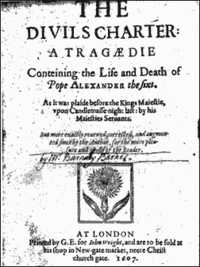The Devil's Charter

The Devil's Charter is an early Jacobean era stage play, a tragedy written by Barnabe Barnes. The play recounts the story of Pope Alexander VI.
Date, performance, publication
The Devil's Charter dates from 1607; it was acted by the King's Men at Court before King James I on Candlemas (2 February) of that year. The play was entered into the Stationers' Register on 16 October 1607, and published before the end of the year, in a quarto printed by George Eld for the bookseller John Wright. Barnes dedicated the play to Sir William Pope and to William Herbert, 3rd Earl of Pembroke. The 1607 quarto is the sole edition of the play prior to the 20th century.[1]
Special features
The play is notable among scholars of English Renaissance theatre for its unusually full stage directions, which reveal much about the dramatic style of the leading company of the age — and for the fact that those stage directions specify the play's characters carrying their props onto the stage with them. Since the characters are historical personages (Charles VIII of France, Lodovico Sforza, Cesare Borgia, and Francesco Guicciardini among others), the effect can be odd and striking; at the start of Act I, scene v, Lucrezia Borgia enters carrying a chair, "which she planteth upon the stage."[2] Characters murder other characters, then drag the bodies offstage.
The text of The Devil's Charter is rich with intellectual, historical, and contemporary Jacobean references.[3] It is not accidental that this anti-Catholic play was written and produced in the aftermath of the Gunpowder Plot of 1605; Protestant propagandists found the story of the Borgia family a useful resource. The story was dramatized again by Nathaniel Lee in his Caesar Borgia (1679).[4]
The devil
The Devil in the play's title is literal rather than metaphorical; Alexander conjures up Astaroth to aid him in his climb to power. (Barnes's play reflects the influences of earlier devil plays, notably Marlowe's Doctor Faustus.) The diabolism of the plot provides opportunities for sensationalism, with multiple ghosts, and stage spectacle, as in the conjuring scene IV,i. (The stage directions there give the King's Men some latitude in special effects: Alexander conjures up an infernal king with a red face, who is "riding upon a lion, or dragon.") At the start of V,v, Astaroth calls up two fellow devils, Belchar and Varca; they converse and dance. In the next and concluding scene, Astaroth, wearing the papal robes, surprises Alexander; the pope learns that the devil has planted tricky arithmetic in their written contract, and that his reign is over years sooner than he expected. Amid thunder and lightning, a horde of devils drag Alexander to Hell.
References
- ↑ E. K. Chambers, The Elizabethan Stage, 4 Volumes, Oxford, Clarendon Press, 1923; Vol. 3, pp. 214–15.
- ↑ F. E. Halliday, A Shakespeare Companion 1564–1964, Baltimore, Penguin, 1964; p. 135.
- ↑ Tanya Pollard, Drugs and Theater in Early Modern England, Oxford, Oxford University Press, 2005; pp. 81-100 and ff.
- ↑ Pauline Kews, "Otway, Lee, and the Restoration History Play," in: A Companion to Restoration Drama. Susan J. Owen, ed. London, Blackwell, 2001; pp. 370-1.